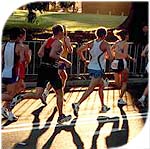|
|
| Taking your exercise out of the gym requires some concessions to nature | |
Q: I have been exercising regularly in a gym and love it. But with the great weather, I am wondering, if I take my workouts outside, will I get as much from them? How will I know? I have been using a treadmill and stationary bike for cardio and using resistance machines for strength. A: I am glad you are thinking inside-out! This is the perfect time of year to shake up your exercise routine. In doing so, you are going to ward off the enemy, boredom, that often undermines a "regular exerciser's" adherence. Even though old habits are hard to break, this is one of the best things you can do for yourself and you will be rewarding both your heart and soul. Adapting your fitness regime outdoors is not complicated. However, it does require some thoughtful planning. First and foremost is the safety issue. Make certain your surroundings are safe and that you are wearing proper shoes and gear to support your choices on the outside. For instance, if you are biking (a perfect tradeoff for your indoor stationary bike), a properly fitted helmet is a must. Progressing gradually so that you become acclimated to summer's heat and humidity is also extremely important. Gyms are usually at a constant cool temperature and have little humidity — but, believe me, on hot days, the demands on your body will be greater outside. Exercising outdoors, you will be sending blood and oxygen not only to your muscles, but also to your skin. Wind is a factor to be considered as well. Plus, if you are biking, rowing or running with a crosswind, it can make your body feel like it is carrying four times its weight. This leads to the question: Can you achieve the same benefits? The answer is yes — but how you perceive your exertion will be important. If you have been running or walking on a treadmill, you are quite familiar with "how you feel" as you do this. You will want to continue to monitor how you feel as you venture outside. You will definitely see differences, since many factors outside are capable of transforming your program into an "interval" workout. This means that you may feel yourself alternate between steady-state (aerobic) activity and high-intensity (anaerobic) activity. Although there is no one scientific formula to calculate the equivalent value of your indoor workout when you're out in nature, most experts agree that going two to three miles inside translates to about a mile outdoors. Karen Esser, an associate professor of kinesiology at the University of Illinois and an avid recreational athlete, believes "that treadmills are more valuable than no workout but are not up to the gold standard of outdoor running." She suggests that the treadmill is easier than outdoor running because the body's hip flexors are less taxed since they are "getting help from the rotating motorized belt." There are other factors that affect the intensity of indoor and outdoor exercise. When you are on a stationary bike, for instance, you can relax, read or watch TV. You aren't forced to keep your hands on handlebars or stay in a particular riding posture. Riding outdoors on a road or on a challenging trail, however, requires more work to stay balanced, which recruits more muscles, such as your abdominals and upper body. Your senses also must stay in tune with your environment, since at any moment you may need to stop, change direction or pick up your pace. You will never have to worry about a dog running across your path on a treadmill in a gym. On the plus side, nature also provides some fitness tools of her own. The resistance machines you have been working on in the gym are all around you outside. You don't need weights, as you can strength-train using your own body weight — push-ups can be done practically anywhere and pull-ups are only a tree limb away. The American Council on Exercise says this about comparing indoor and outdoor workouts: "The body has to make corrections for differences in surface, especially in the legs and torso. There are a number of terrain coefficients that researchers have calculated to show the extra work for muscles." Your body must absorb greater impact with every step outdoors, while indoors you are on a cushioned track. You will feel heavier as the knees and joints will take a pounding. So taking all these things into consideration, it can be an exhilarating experience to turn yourself inside-out. Communing with nature and blending beautiful vistas into your workout will be more than enough to convince you to get off the beaten path. Good Luck! |

